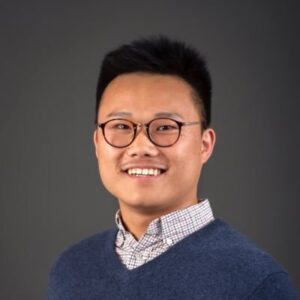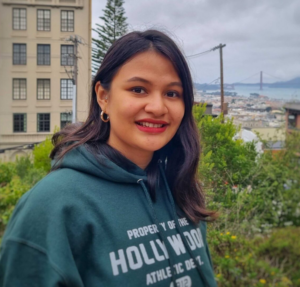We’re taking time to get to know the members of the GSA’s Early Career Scientist Committees. Join us to learn more about our early career scientist advocates.

Peiwei Chen
Accessibility Subcommittee
California Institute of Technology
Research Interest
Far from a harmonious place, the genome is a battleground, where every bit of DNA fights for inheritance and evolutionary survival. While most genes do so by conferring fitness advantages to the host, selfish elements cheat the process by enhancing their own transmission at the cost of the host, causing intragenomic conflicts.
My current work focuses on a specific type of intragenomic conflict between the host genome and transposons—a class of selfish elements that proliferate in the genome without immediate benefits to the host. To counteract the selfish action of transposons, animals evolve the piRNA pathway, which uses short stretches of non-coding RNAs, so-called piRNAs, to identify and silence transposons. Instead of being defeated, however, transposons constantly invent ways to evade host surveillance mechanisms, which trigger the host to innovate novel mechanisms to keep transposons in check. As a result, intragenomic conflicts spur cycles of innovations and counter-innovations in the genome, giving rise to a variety of genetic novelties within a short period of evolutionary time. My work aims to understand how intragenomic conflicts trigger innovations and how innovations, in turn, fuel intragenomic conflicts. In addition to the host-transposon conflict, I am also very interested in meiotic drives, intralocus sexual conflicts, and other types of intragenomic conflicts. Through studying different kinds of intragenomic conflicts, I hope to elucidate the evolutionary driving forces and molecular underpinnings of genetic innovations, ultimately gaining insights into why and how novelties arise in evolution.
As a PhD-trained scientist, you have many career options. What interests you the most?
My career goal is to conduct curiosity-driven research at a university or research institute. Growing up, I have always been curious about the inner workings of life, and I enjoy wondering why life is the way it is. I was fortunate to be in a position to study what most interested me in college—biology—and I fell in love with the endless hypothesis-testing cycles, filled with hands-on experimentations. In academia, you can ask curious questions without needing a justification for how they could immediately translate to something profitable; yet, you know that by understanding how life works at a very fundamental level, your work will inform novel therapeutics and revolutionize future medicine. It is such a thrilling feeling when you discover something. You cannot wait to share it with everyone around you and the rest of the world—be it a new gene, a new pathway, or a new theory. I really enjoy doing basic biology research, so I hope to have a career in academia to keep doing what I love.
As I reflect on my journey, I come to realize just how many fantastic mentors and teachers I have had. I was given my first independent research project in my sophomore year, when I was in Tom Cheung’s lab at HKUST. Tom initially declined my request to do research in his lab, citing the lack of any advanced biology classes in my transcript, but instead of just turning me away, he invited me to meet him every week to discuss literature related to his work. He would walk me through every experiment in the paper and patiently explain the most basic concepts. Over time, I managed to overcome my fear of 20-page articles written in a language that, at the time, I still needed a dictionary to fully comprehend, so I finally convinced Tom to let me join his lab. I ended up making my first (small) discovery in his lab. Though it was never published, that project took a permanent place in my heart. I could go on and on about other amazing mentors and teachers in my life—Alex Hoffmann, Angela Stathopoulos, Alexei Aravin, Yukiko Yamashita… I tend to think that they shaped me into who I am as a scientist. Beyond my own personal experience, training the future generations of scientists is undoubtedly pivotal for our scientific enterprise, so I aspire to be a good mentor like the mentors I have had. As scientists, we have the duty to train future scientists, and that is an integral part of the job—arguably a part that is as satisfying and exciting as making scientific discoveries.
In addition to your research, how do you want to advance the scientific enterprise?
Talent is everywhere, but resources are not. The 21st century has witnessed some of the most disruptive technological advances that transform education. Unfortunately, educational disparities across the globe are restricting access to these advances and other educational resources. The western world is no exception to this haunting reality. In the United States, for example, educational inequality is significantly limiting upward social mobility, disproportionally affecting racial and ethnic minority groups and families facing socioeconomic barriers. This is a pressing problem for STEM education, where hands-on learning is critical to developing students’ interest and success in STEM subjects. Many public schools across the country lack the resources and proper infrastructure to provide students with hands-on and interactive science education. In the long run, such disparities in access to high-quality education that nurtures interests in STEM fields are widening the socioeconomic gap in our society, forming a vicious cycle with seemingly no exit.
I became increasingly concerned with this social issue of unequal access to educational resources after learning about my undergrad student’s personal experience. This student grew up in Central Valley, a region of California overshadowed by the more popular, attention-grabbing areas, such as Silicon Valley and Hollywood. In contrast to Los Angeles and other urban areas, Central Valley is dominated by agricultural sectors and scarce educational resources. Through ongoing conversations with my student, I was able to learn more about the challenges and constraints students dealt with there. I was saddened to hear that many lab classes in their high school were turned into free periods due to a shortage of functioning lab equipment and funding. This is in stark contrast to my educational upbringing and experience at Caltech, where I am privileged to enjoy curiosity-driven research and scientific discovery with few resource constraints. Hearing that a high school located two hours from Caltech has 40 students sharing one Bunsen burner in chemistry class was jarring.
To make hands-on science education more accessible for less-privileged students, I launched a new initiative at Caltech in early 2022 called Lab Equipment Access Program (LEAP). LEAP aims to help underserved public high schools get equipment and supplies from labs at Caltech. I envision LEAP to be a long-term hub on campus where surplus, functional lab equipment is collected and donated to public high schools in need. In addition to calling for donations, I am advocating on campus through educational events to raise awareness on unequal access to resources. To reach more people, I have built a website to promote LEAP and educate the public on the cause. I am also recruiting volunteers to join LEAP, aiming to create a ripple effect where more people at Caltech engage in tackling this social issue. By addressing the constraints posed by limited resources, I aim to empower students from underserved communities to make a “LEAP” towards their own goals. Ultimately, I hope to help create a future in which hands-on science education is accessible to everyone and talents everywhere can shine.
As a leader within the Genetics Society of America, what do you hope to accomplish?
As a member of the Accessibility Subcommittee at GSA, I hope to promote the accessibility of different scientific activities within the genetics community. I see many hidden barriers that prevent science and genetic research from being truly accessible to everyone, especially those with disabilities. A friend of mine has limb-girdle muscular dystrophy type 2A (LGMD2A), an autosomal recessive genetic disease caused by mutations of a single gene, calpain-3. Despite clear etiology, there is no cure for LGMD2A. Patients with LGMD2A suffer from progressive muscle weakness that sometimes only begins to manifest in their 20s, eventually making walking impossible. Being saddened by my friend’s situation, I have become even more concerned about many more people in our community who have disabilities in one form or another. My strong desire to help people from disadvantaged backgrounds has propelled me to find ways to help increase the accessibility for those often-ignored members of our community.
Working with staff at GSA, I am excited about a new workshop series called Accessibility in STEM (AiS) that we launched in late 2022. Through the AiS Workshop Series, we hope to explore different facets of accessibility challenges in STEM with diverse community members and discuss practical ways to tackle these challenges. We also plan to highlight the voices of people with disabilities in STEM, center their lived experiences, and motivate the community as a whole to work towards a future where genetics education and research are accessible for everyone. I also work with our subcommittee on a number of other initiatives: a new blog series on accessibility resources, reviewing project proposals to ensure the accessibility, advocating for accessibility changes in journals and conferences, and many more. I firmly believe that a future in which everyone is welcomed, supported, and celebrated in the genetics community is possible—and I work towards that future with my fellow geneticists at GSA and beyond through active advocacy.
Previous leadership experience
- Founder and President, Lab Equipment Access Program (LEAP) at Caltech
- Head Student Ambassador, The Hong Kong University of Science and Technology
- Co-organizer, Cambodia Service Trip




